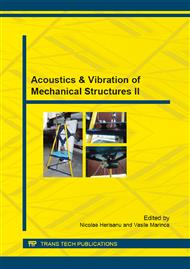p.284
p.290
p.295
p.303
p.312
p.317
p.323
p.328
p.333
Vibroacustical Method for Measuring the Effect of Cavitation Erosion
Abstract:
One of the most harmful effects of cavitation, with strong influence on the life of the hydraulic machines is the destruction caused by erosion Since its discovery, over 150 years ago, evaluating the degradation is achieved by mass of material removed by erosion in a given time, which in the case of rotors and blades of hydraulic machines and marine propeller blades are equivalent by amount of electrode consumption for filling the voids left by the removal of material. Laboratory research on cavitation, from the beginning until now, evaluates the intensity of cavitation erosion rate, defined as a mass of material removed by erosion at a certain time of attack.The purpose of this paper is to develop and validate a technique based on vibroacoustic signal analysis of corroded samples, and that through their natural frequencies deviations to emphasize mass loss.The experimental measurement of the vibroacustic response of corroded specimens is carried out by using a condenser microphone. The vibration responses, in free-free conditions of the specimens, are analyzed using algorithm based on Fast Fourier Transform (FFT). The results are compared with other indicators of cavitation corrosion, such as lost mass and mass loss rate.
Info:
Periodical:
Pages:
317-322
Citation:
Online since:
October 2015
Price:
Сopyright:
© 2015 Trans Tech Publications Ltd. All Rights Reserved
Share:
Citation:


